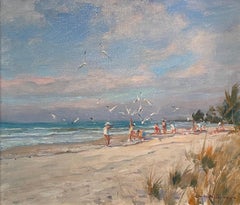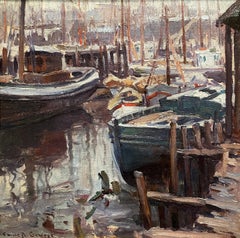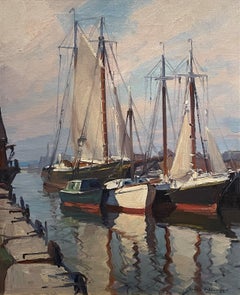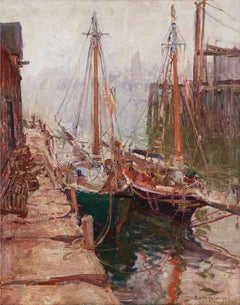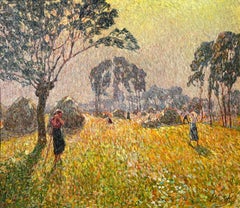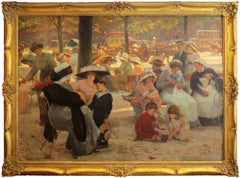Emile Gruppe Art
1896-1978
Emile Gruppe (1896-1978) was an unusually prolific artist. He was at his easel almost every day and created thousands of paintings over a career that lasted 60 years. At his peak, he was completing almost 200 oil paintings a year. Yet he has never failed to find an audience for his depictions of New England in autumn and winter, or his harbor scenes of Rockport and Gloucester in Massachusetts.
Gruppe was born in 1896 in Rochester, New York to an artistic family--his father, brother, sister and nephew were all artists. Emile spent his youth in Holland, where his father, Charles Gruppe, worked as an artist. Emile lived in the Netherlands until he was 17, when the family returned permanently to the United States to avoid World War I.
In New York City, Gruppe attended classes at the National Academy of Design and at the Art Students League, where he studied under Charles Chapman and George Bridgman. He also studied with John Carlson in Woodstock, New York, where he gained an appreciation for outdoor painting. Carlson “turned me into a painter,” he later said.
Gruppe helped found the Rockport Art Association in 1921, but he is most closely linked to Gloucester where he lived from about 1940 until his death. He operated the Gloucester School of Painting from the 1940s into the 1970s and helped turn the Rocky Neck area of East Gloucester into a world-famous art colony. The school boasted an impressive faculty but Gruppe’s own exuberant plein-air demonstrations were often the highlight of the week.
Gloucester, with its fleet of whimsically painted fishing vessels, crowded wharf buildings and shacks, and picturesque inhabitants, never ceased to fascinate Gruppe. He also helped popularize Rockport’s famous fishing shack known as Motif #1, sometimes called “the most often-painted building in America.”
By the 1940s, Gruppe was one of the most prominent of the Cape Ann artists, a group that included Frederick Mulhaupt, Anthony Thieme, Theresa Bernstein, Marguerite Pierson, William Lester Stevens, and Aldro Thompson Hibbard. The painters of this ‘Cape Ann School’ were some of the first U.S. artists to employ plein air painting techniques. Gruppe’s style, which tended toward Tonalism early in his career, mutated into a bold impressionism in the 1940s and 1950s.
Gruppe occasionally traveled to Jeffersonville, VT where he loved to paint the picturesque country roads, farms, and forests, sometimes with distinctive white birch trees. Later in life, he wintered in Florida where he painted some tropical scenes. Though Gruppe suffered a stroke in the early 1970s, he continued to paint until his death in 1978. On the morning he died, the 82-year-old artist had stretched a canvas in preparation for a day of painting.
Gruppe’s portrayals of the archetypal the houses, harbors, and rural landscape of New England have never gone out of style. His expressive impressionistic paintings continue to appeal to twenty-first-century sensibilities of a seemingly eternal New England, barely touched by modernity.(Biography provided by Helicline Fine Art)
to
4
4
2
1
1
1
2
1
Overall Height
to
Overall Width
to
3
4
4
3
2
1
1
1
1
1
1
1
1
1
1
4
1
6
19
13
12
6
4
4
4
4
Artist: Emile Gruppe
Dealer: Lincoln Glenn
"Feeding the Gulls" Emile Gruppe, Florida Coastal Beach Scene, Impressionist
By Emile Gruppe
Located in New York, NY
Emile Gruppe
Feeding the Gulls
Signed lower right
Oil on canvas
20 x 24 inches
Emile Gruppe was an unusually prolific artist. He was at his easel almost every day and created thousa...
Category
Mid-20th Century Impressionist Emile Gruppe Art
Materials
Oil, Canvas
"Rainy Day" Emile Gruppe, Cape Ann, Rockport, Gloucester, Impressionist
By Emile Gruppe
Located in New York, NY
Emile Gruppe
Rainy Day
Signed lower left
Oil on canvas
16 x 16 inches
Emile Gruppe was an unusually prolific artist. He was at his easel almost every day and created thousands of pa...
Category
Mid-20th Century Impressionist Emile Gruppe Art
Materials
Oil, Canvas
"Drying the Sails" Emile Gruppe, Cape Ann, Rockport, Gloucester, Impressionist
By Emile Gruppe
Located in New York, NY
Emile Gruppe
Drying the Sails
Signed lower right
Oil on canvas
24 x 20 inches
Emile Gruppe was an unusually prolific artist. He was at his easel almost every day and created thousan...
Category
Mid-20th Century Impressionist Emile Gruppe Art
Materials
Oil, Canvas
"Waiting for the Tide to Rise, " Emile Gruppe, Boats at Dock, Cape Ann School
By Emile Gruppe
Located in New York, NY
Emile Gruppe
Waiting for the Tide to Rise, circa 1930s
Signed lower right
Oil on canvas
40 x 32 inches
Provenance:
Newman Galleries, Philadelphia, Pennsylvania (as Waiting for Sunrise).
Acquired directly from the above.
Private Collection, Pennsylvania.
Emile Gruppe was an unusually prolific artist. He was at his easel almost every day and created thousands of paintings over a career that lasted 60 years. At his peak, he was completing almost 200 oil paintings a year. Yet he has never failed to find an audience for his depictions of New England in autumn and winter, or his harbor scenes of Rockport and Gloucester in Massachusetts.
Gruppe was born in 1896 in Rochester, New York to an artistic family--his father, brother, sister and nephew were all artists. Emile spent his youth in Katwyk an Zee, a fishing village in Holland, where his father, Charles Gruppe, worked as both an artist and an art dealer. Emile lived in the Netherlands until he was 17, when the family returned permanently to the United States to avoid World War I.
In New York City, Gruppe attended classes at the National Academy of Design and at the Art Students League, where he studied under Charles Chapman and George Bridgman. He also studied with John Carlson in Woodstock, New York, where he gained an appreciation for outdoor painting. Carlson “turned me into a painter,” he later said.
Gruppe helped found the Rockport Art Association in 1921, but he is most closely linked to Gloucester where he lived from about 1940 until his death. He operated the Gloucester School of Painting from the 1940s into the 1970s and helped turn the Rocky Neck area of East Gloucester into a world-famous art colony. The school boasted an impressive faculty but Gruppe’s own exuberant plein-air demonstrations were often the highlight of the week.
Gloucester, with its fleet of whimsically painted fishing vessels, crowded wharf buildings and shacks, and picturesque inhabitants, never ceased to fascinate Gruppe. He also helped popularize Rockport’s famous fishing shack known as Motif #1, sometimes called “the most often-painted building in America.”
By the 1940s, Gruppe was one of the most prominent of the Cape Ann artists...
Category
1930s Emile Gruppe Art
Materials
Canvas, Oil
Related Items
The Harvest
Located in London, GB
Farmhands working in a field on a hot summer's day.
Building on iconic depictions of farmworkers by Millet, Huys sought to imbue his figures with a sensitivity and reverence that ...
Category
20th Century Emile Gruppe Art
Materials
Canvas, Oil
"Sunday in the Park, 1910"
By Cyprien Eugène Boulet
Located in Lambertville, NJ
Signed Lower Right
Cyprien-Eugène Boulet (1877 - 1927)
Category
Early 20th Century Impressionist Emile Gruppe Art
Materials
Canvas, Oil
Winter Moonlight
By George William Sotter
Located in Lambertville, NJ
signed lower right
Category
1910s American Impressionist Emile Gruppe Art
Materials
Canvas, Oil
"Winter Storm, NYC"
By Johann Berthelsen, 1883-1972
Located in Lambertville, NJ
Jim’s of Lambertville Fine Art Gallery is proud to offer this piece by Johann Berthelsen (1883 – 1972).
Born in 1883 in Denmark to artistically inclined parents, Johann Berthelsen would become a widely successful singer, teacher, and painter. After his parents divorced, his mother brought Berthelsen and his siblings with her to the United States in 1890, eventually settling in Wisconsin.
At eighteen, Berthelsen moved to Chicago in the hope of becoming an actor, but a friend at the Chicago Musical College convinced him to audition at his school. Berthelsen received a full scholarship and enrolled at the college, where he was awarded the Gold Medal twice. After graduating, he had an active career traveling across the United States and Canada performing in operas and concerts, before joining the voice faculty at his alma mater in 1910. In 1913, Berthelsen became the voice department director at the Indianapolis Conservatory of Music.
While in Chicago, Berthelsen met the landscape painter, Svend Svendsen...
Category
20th Century American Impressionist Emile Gruppe Art
Materials
Oil, Canvas
"In Port"
By Edward Willis Redfield
Located in Lambertville, NJ
Jim’s of Lambertville is proud to offer this artwork by:
Edward Willis Redfield (1869 - 1965)
Edward W. Redfield was born in Bridgeville, Delaware, moving to Philadelphia as a young child. Determined to be an artist from an early age, he studied at the Spring Garden Institute and the Franklin Institute before entering the Pennsylvania Academy from 1887 to 1889, where he studied under Thomas Anshutz, James Kelly, and Thomas Hovenden. Along with his friend and fellow artist, Robert Henri, he traveled abroad in 1889 and studied at the Academie Julian in Paris under William Bouguereau and Tony Robert-Fleury. While in France, Redfield met Elise Deligant, the daughter of an innkeeper, and married in London in 1893.
Upon his return to the United States, Redfield and his wife settled in Glenside, Pennsylvania. He remained there until 1898, at which time he moved his family to Center Bridge, a town several miles north of New Hope along the Delaware River. Redfield painted prolifically in the 1890s but it was not until the beginning of the twentieth century that he would develop the bold impressionist style that defined his career. As Redfield’s international reputation spread, many young artists gravitated to New Hope as he was a great inspiration and an iconic role model. Edward Redfield remained in Center Bridge throughout his long life, fathering his six children there.
Around 1905 and 1906, Redfield’s style was coming into its own, employing thick vigorous brush strokes tightly woven and layered with a multitude of colors. These large plein-air canvases define the essence of Pennsylvania Impressionism. By 1907, Redfield had perfected his craft and, from this point forward, was creating some of his finest work.
Redfield would once again return to France where he painted a small but important body of work between 1907 and 1908. While there, he received an Honorable Mention from the Paris Salon for one of these canvases. In 1910 he was awarded a Gold Medal at the prestigious Buenos Aires Exposition and at the Panama-Pacific Exposition of 1915 in San Francisco, an entire gallery was dedicated for twenty-one of his paintings.
Since Redfield painted for Exhibition with the intent to win medals, his best effort often went into his larger paintings. Although he also painted many fine smaller pictures, virtually all of his works were of major award-winning canvas sizes of 38x50 or 50x56 inches. If one were to assign a period of Redfield’s work that was representative of his “best period”, it would have to be from 1907 to 1925. Although he was capable of creating masterpieces though the late 1940s, his style fully matured by 1907 and most work from then through the early twenties was of consistently high quality. In the later 1920s and through the 1930s and 1940s, he was like most other great artists, creating some paintings that were superb examples and others that were of more ordinary quality.
Redfield earned an international reputation at a young age, known for accurately recording nature with his canvases and painting virtually all of his work outdoors; Redfield was one of a rare breed. He was regarded as the pioneer of impressionist winter landscape painting in America, having few if any equals. Redfield spent summers in Maine, first at Boothbay Harbor and beginning in the 1920s, on Monhegan Island. There he painted colorful marine and coastal scenes as well as the island’s landscape and fishing shacks. He remained active painting and making Windsor style furniture...
Category
Early 1900s American Impressionist Emile Gruppe Art
Materials
Canvas, Oil
"Forest Strongholds"
By John F. Carlson
Located in Lambertville, NJ
Signed lower right. Complemented by a hand carved and gilt frame.
Exhibited at the National Academy of Design, 1928
Category
20th Century American Impressionist Emile Gruppe Art
Materials
Canvas, Oil
"The Neighbors"
By George William Sotter
Located in Lambertville, NJ
Jim’s of Lambertville is proud to offer this artwork.
Signed lower right and is Illustrated in the Ashley John Gallery catalog titled "The Pennsylvania Impressionists".
George William Sotter (1879 - 1953)
Born in Pittsburgh on September 25, 1879, Sotter began his art education with local teachers and with Henry G. Keller, who had studied in various German academies. Keller, known for his superb, atmospheric watercolors, taught at the Cleveland School of Art but Sotter studied with him in Pittsburgh. Later Sotter would exhibit between 1903 and 1937 at the Pennsylvania Academy of the Fine Arts. His works were also shown at the Corcoran Gallery (1912-23), the Carnegie International (1901-26), the National Academy of Design (1913 and 1921), and at the Art Institute of Chicago (1911-27). In 1915, Sotter exhibited four works at the Panama-Pacific International Exposition in San Francisco, where he won a silver medal. Sotter was known mainly as a stained-glass artist; his work may be seen from New York City to Salt Lake City. Around a dozen craftsmen worked under him for these commissions.
Sotter spent the summer of 1902 with Pennsylvania impressionist Edward Redfield in Boothbay Harbor, Maine. Between 1910 and 1919, Sotter taught at the Carnegie Institute of Technology. His paintings often feature large areas of sky filled with clouds and he frequently painted winter night scenes, such as Moonlight, Bucks County (Beacon Hill Fine Art), a perfectly successful depiction of a quiet, moonlit landscape filled with twinkling stars. Star-studded skies, although rare in landscape painting, go back at least to 1600 when they appear in the oeuvre of Adam Elsheimer...
Category
20th Century American Impressionist Emile Gruppe Art
Materials
Oil, Canvas
"Solebury Valley"
By William Langson Lathrop
Located in Lambertville, NJ
Signed lower right.
Complemented by a period frame.
William L. Lathrop (1859-1938)
Deemed “Father of the New Hope Art Colony”, William Langson Lathrop was born in Warren, Illinois. He was largely self-taught, having only studied briefly with William Merritt Chase in 1887, at the Art Students League. Lathrop first moved east in the early 1880s, and took a job at the Photoengraving Company in New York City. While there, he befriended a fellow employee, Henry B. Snell. The two men became lifelong friends and ultimately, both would be considered central figures among the New Hope Art Colony.
Lathrop's early years as an artist were ones of continuing struggle. His efforts to break through in the New York art scene seemed futile, so he scraped enough money together to travel to Europe with Henry Snell in1888. There he met and married an English girl, Annie Burt. Upon returning to New York, he tried his hand at etching, making tools from old saw blades...
Category
1910s American Impressionist Emile Gruppe Art
Materials
Canvas, Oil
The Bather by Childe Hassam
By Childe Hassam
Located in New Orleans, LA
Childe Hassam
1859-1935 American
The Bather
Signed and dated “Childe Hassam” (lower right)
Oil on canvas
Considered by many to be America’s foremost Impressionist painter, Childe Hassam composed his tranquil and intimate oil on canvas The Bather in the early years of the 20th century. The creation of the artwork aligns with a period of Hassam’s career where the artist’s palette was transforming, matching ever closer with the pale and pastel hues of French Impressionists like Claude Monet. Even the subject — a nude woman — represents a greater alignment with the Impressionist project, as artists of the movement and their non-mythological and non-biblical nudes still generated cries of indecency. With Hassam’s signature brushwork and attention to color, The Bather serves as a dream-like vision, serene and sensuous, of a young woman bathing in a lush forest.
While the artist's skill for landscape painting is on display, it is Hassam's command of form, light and color that brings this canvas to life. He creates a captivating composition, placing the nude subject in the bottom left of the canvas. The soft, undulating curves of the woman's body in contrapposto and the glow of her fair skin are balanced by the strong verticals and deep earth tones of the tall trees to her right. Hassam delicately frames the nude in the vivid blues of the distant water, building luminous color that further draws the viewer’s eye and results in a somewhat voyeuristic appeal — endowing his nude with both a natural innocence and an intentional sensuality.
Born in Dorchester, Massachusetts, Childe Hassam began his artistic career as a freelance illustrator, working for national publications such as Harper’s Weekly, Scribner’s Monthly, and The Century. His first solo exhibition of watercolors took place in Boston in 1883, and he quickly catapulted onto the international scene, winning a bronze medal at the Exposition Universelle in Paris in 1889. The year before the present work was created, he received the Webb Prize from the Society of American Artists for another landscape painted at Gloucester. Hassam would receive numerous other awards throughout his career, most notably the Gold Medal for Distinguished Services to Fine Art from the American Dealers Association. A true master, Hassam depicted a way of life characteristic of both American and French society, and his work elucidates a critical chapter in American art history. Today, his work resides in the Oval Office of the White House and in numerous important museums, including the Metropolitan Museum of Art in New York, the National Gallery of Art in Washington, DC and the Museum of Fine Arts in Boston, among others.
This painting will be included in Stuart P. Feld's and Kathleen M. Burnside's forthcoming catalogue raisonné of the artist's work.
Circa 1905
Canvas: 24 1/2“ high x 20 18” wide
Frame: 35 7/8“ high x 31 1/4” wide x 3 1/4“ deep
Provenance:
Private Collection of William Young...
Category
20th Century Impressionist Emile Gruppe Art
Materials
Oil, Canvas
"Mountain Labyrinths"
By John F. Carlson
Located in Lambertville, NJ
Ashley John is proud to offer this artwork by:
John Fabian Carlson (1874/75 - 1945)
John F. Carlson was one of the leading American landscape p...
Category
Early 20th Century Tonalist Emile Gruppe Art
Materials
Canvas, Oil
San Pedro Harbor
By Paul Sample
Located in New York, NY
It is infrequent, to say the least, that a diagnosis of tuberculosis proves fortuitous, but that was the event, in 1921, that set Paul Starrett Sample on the road to becoming a professional artist. (The best source for an overview of Sample’s life and oeuvre remains Paul Sample: Painter of the American Scene, exhib. cat., [Hanover, New Hampshire: Hood Museum of Art, 1988] with a detailed and definitive chronology by Sample scholar, Paula F. Glick, and an essay by Robert L. McGrath. It is the source for this essay unless otherwise indicated.) Sample, born in Louisville, Kentucky, in 1896 to a construction engineer and his wife, spent his childhood moving with his family to the various locations that his father’s work took them. By 1911, the family had landed in Glencoe, Illinois, settling long enough for Paul to graduate from New Trier High School in 1916. Sample enrolled at Dartmouth College, in Hanover, New Hampshire, where his interests were anything but academic. His enthusiasms included the football and basketball teams, boxing, pledging at a fraternity, and learning to play the saxophone. After the United States entered World War I, Sample, to his family’s dismay, signed on for the Naval Reserve, leading directly to a hiatus from Dartmouth. In 1918 and 1919, Sample served in the U.S. Merchant Marine where he earned a third mate’s license and seriously contemplated life as a sailor. Acceding to parental pressure, he returned to Dartmouth, graduating in 1921. Sample’s undergraduate life revolved around sports and a jazz band he formed with his brother, Donald, two years younger and also a Dartmouth student. In November 1933, Sample summarized his life in a letter he wrote introducing himself to Frederick Newlin Price, founder of Ferargil Galleries, who would become his New York art dealer. The artist characterized his undergraduate years as spent “wasting my time intensively.” He told Price that that “I took an art appreciation course and slept thru it every day” (Ferargil Galleries Records, circa 1900–63, Archives of American Art, Smithsonian Institution, available on line).
In 1920, Donald Sample contracted tuberculosis. He went for treatment to the world-famous Trudeau Sanitorium at Saranac Lake, in New York State’s Adirondack Mountains for the prescribed regimen of rest, healthful food, and fresh air. Visiting his brother in 1921, Paul also contracted the disease. Tuberculosis is highly contagious, and had no certain cure before the development of streptomycin in 1946. Even for patients who appeared to have recovered, there was a significant rate of recurrence. Thus, in his letter to Price, Sample avoided the stigma conjured by naming the disease, but wrote “I had a relapse with a bad lung and spent the next four years hospitalized in Saranac Lake.” The stringent physical restrictions imposed by adherence to “the cure” required Sample to cultivate an alternate set of interests. He read voraciously and, at the suggestion of his physician, contacted the husband of a fellow patient for instruction in art. That artist, then living in Saranac, was Jonas Lie (1880–1940), a prominent Norwegian-American painter and an associate academician at the National Academy of Design. Lie had gained renown for his dramatic 1913 series of paintings documenting the construction of the Panama Canal (The Metropolitan Museum of Art, New York; United States Military Academy, West Point, New York). Primarily a landscape artist, Lie had a particular affinity for scenes with water. His paintings, impressionistic, atmospheric, and brushy, never strayed from a realistic rendering of his subject. Sample regarded Lie as a mentor and retained a lifelong reverence for his teacher. Sample’s early paintings very much reflect Lie’s influence.
`
In 1925, “cured,” Sample left Saranac Lake for what proved to be a brief stay in New York City, where his veteran’s benefits financed a commercial art course. The family, however, had moved to California, in the futile hope that the climate would benefit Donald. Sample joined them and after Donald’s death, remained in California, taking classes at the Otis Art Institute in Los Angeles. In Sample’s account to Price, “I couldn’t stomach the practice of painting a lot of High Sierras and desert flowers which seemed to be the only kind of pictures that were sold here so I got a job teaching drawing and painting at the art school of the University of Southern California.” Initially hired as a part-time instructor, Sample progressed to full-time status and ultimately, by the mid-1930s, to the post of Chairman of the Fine Art Department. Sample, however, did not want to wind up as a professor. “Teaching is all right in small doses,” he wrote, “but I have a horror of drifting into being a college professor and nothing more.” At the same time as he taught, Sample began to exhibit his work in a variety of venues at first locally, then nationally. Though he confessed himself “a terrible salesman,” and though occupied with continued learning and teaching, Sample was nonetheless, ambitious. In 1927, he wrote in his diary, “I am eventually going to be a painter and a damned good one. And what is more, I am going to make money at it” (as quoted by Glick, p. 15). In 1928, Sample felt sufficiently solvent to marry his long-time love, Sylvia Howland, who had also been a patient at Saranac Lake. The Howland family were rooted New Englanders and in summertime the Samples regularly traveled East for family reunion vacations.
While the 1930s brought serious hardship to many artists, for Paul Sample it was a decade of success. Buttressed by the financial safety net of his teacher’s salary, he painted realist depictions of the American scene. While his work addressed depression-era conditions with a sympathetic eye, Sample avoided the anger and tinge of bitterness that characterized much contemporary realist art. Beginning in 1930, Sample began to exhibit regularly in juried exhibitions at important national venues, garnering prizes along the way. In 1930, Inner Harbor won an honorable mention in the Annual Exhibition of the Art Institute of Chicago. That same year Sample was also represented in a show at the Albright-Knox Gallery in Buffalo and at the Biennial Exhibition of the Corcoran Gallery of Art, Washington, D.C. In 1931, Dairy Ranch won the second Hallgarten Prize at the Annual Exhibition of the National Academy of Design, in New York. Sample also made his first appearances at the Carnegie Institute, Pittsburgh, and The Pennsylvania Academy of the Fine Arts, Philadelphia. In 1936, Miner’s Resting won the Temple Gold Medal at the Pennsylvania Academy’s Annual Exhibition. Always interested in watercolor, in 1936, Sample began to send works on paper to exhibitions at the Whitney Museum, New York.
While participating in juried exhibitions, Sample also cultivated commercial possibilities. His first New York art dealer was the prestigious Macbeth Gallery in New York, which included his work in a November 1931 exhibition. In 1934, Sample joined the Ferargil Galleries in New York, after Fred Price arranged the sale of Sample’s Church Supper to the Michele and Donald D’Amour Museum of Fine Arts in Springfield, Massachusetts. In 1937, The Metropolitan Museum of Art purchased Sample’s Janitor’s Holiday from the annual exhibition of the National Academy of Design, a notable honor.
As prestigious as this exhibition schedule may have been, by far Sample’s most visible presence in the 1930s and 1940s was the result of his relationship with Henry Luce’s burgeoning publishing empire, Time, Inc. Sample’s first contribution to a Luce publication appears to have been another San Pedro...
Category
20th Century American Modern Emile Gruppe Art
Materials
Canvas, Oil
Strawberries Strewn on a Forest Floor
By William Mason Brown
Located in New York, NY
William Mason Brown was born in Troy, New York, where he studied for several years with local artists, including the leading portraitist there, Abel Buel Moore. In 1850, he moved to ...
Category
19th Century American Realist Emile Gruppe Art
Materials
Canvas, Oil
Emile Gruppe art for sale on 1stDibs.
Find a wide variety of authentic Emile Gruppe art available for sale on 1stDibs. You can also browse by medium to find art by Emile Gruppe in oil paint, paint, canvas and more. Much of the original work by this artist or collective was created during the 20th century and is mostly associated with the Impressionist style. Not every interior allows for large Emile Gruppe art, so small editions measuring 16 inches across are available. Customers who are interested in this artist might also find the work of John Whorf, Anthony Thieme, and Emile Albert Gruppe. Emile Gruppe art prices can differ depending upon medium, time period and other attributes. On 1stDibs, the price for these items starts at $5,800 and tops out at $35,000, while the average work can sell for $18,500.
